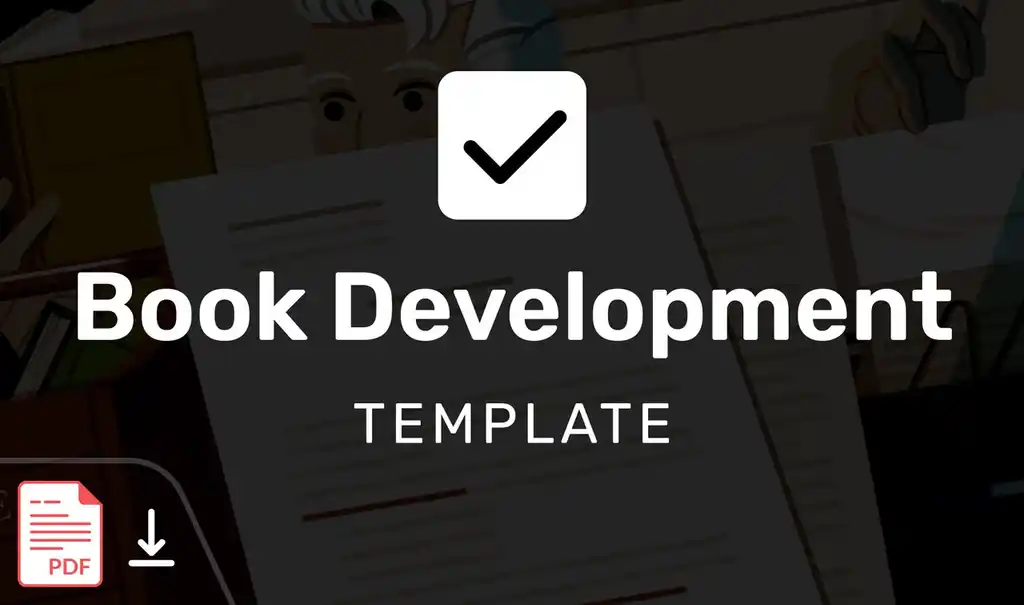Guides • Perfecting your Craft
Last updated on Oct 15, 2025
How to Write an Ebook (in 7 Super Simple Steps)
Martin Cavannagh
Head of Content at Reedsy, Martin has spent over eight years helping writers turn their ambitions into reality. As a voice in the indie publishing space, he has written for a number of outlets and spoken at conferences, including the 2024 Writers Summit at the London Book Fair.
View profile →Ebooks are one of the best marketing tools available to entrepreneurs, not to mention an amazing way to instantly boost your business's credibility and visibility. In this part of our guide, we’ll run you through how to create an ebook that will stand out, from coming up with your idea to perfecting your final product.
Here's how to write an ebook in 7 steps:
1. Research your target market
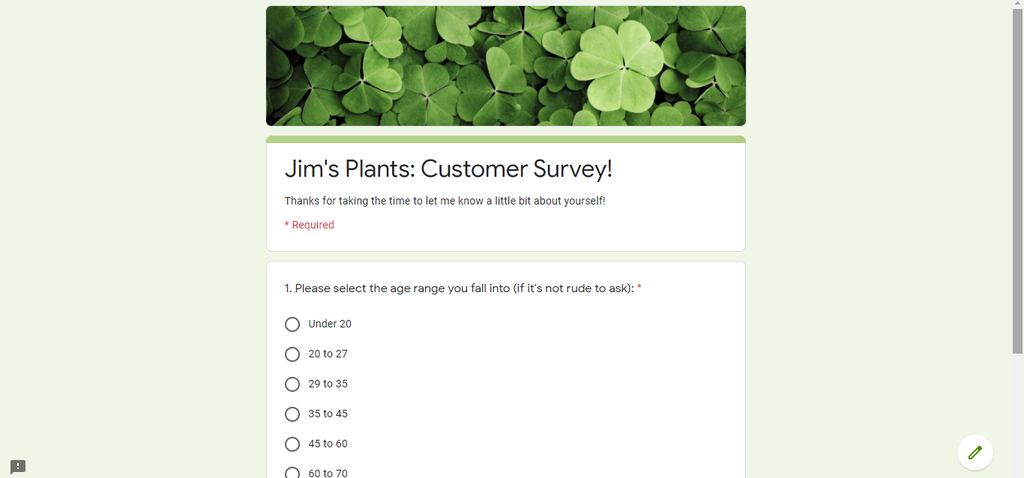
If you’re creating an ebook as a way to market your business, that target audience should be the same as your product or service. If you’re creating an ebook as a self-contained product, you’ll want to do more research into your ideal readers.
Your user base won’t be a monolith, but it can help to generalize for a hot second with factors like age, types of occupation, or level of disposable income. These insights can help make choices about the topic you write about or the solutions you suggest, so it’s important to conduct some research into them. Let’s take a hypothetical example:
Jim runs an online store selling plants. He can assume that his buyers have some disposable income, but has no other insight into them. In order to learn more about who he’s selling to, he sends a questionnaire to his mailing list and learns that his core customer base is:
— Predominantly millennials
— Split evenly along gender lines
— Largely living in apartments or condos without garden space.
— Relatively inexperienced with plant care.
— Likely to spend most of their free time away from home.
— Keen to increase their collection of houseplants.
These insights will come in very handy through pretty much every step of the process. So don’t skimp on the consumer research.
Once you’ve gathered your data, you need to burrow into that reader’s mind and choose your topic wisely — more on that next!
Free course: Finding your target readers
Identify your target readers, find out where they 'live', and get them to buy your book. Get started now.
2. Choose your topic
In the course of your market research, you’ll hopefully have considered who your reader is and what they might want from an ebook. This will be key in determining its topic. If you have no idea where to start, a good tactic is to get inside your reader’s head and ask yourself the following questions:
- What would be useful for your target reader?
- Is there a question your audience repeatedly asks? Can you provide an answer?
- Is there a resource your target reader is looking for?
- Is there a topic that you have posted about before that you feel could be expanded upon in longer form content? (If you’re a blogger who already has a lot of material to work with, you can check out our tips on how to convert your blog into a book).
Pro tip alert! 📣 If you’re really struggling to know what your audience is looking for, ask them! A survey of your existing users asking them what they’d like to see can help you identify what they’re after.
While you may be tempted to use your ebook exclusively to advertise your own product or service, people are unlikely to read pure promotional material (and even less likely to recommend it to friends). Instead, identify a need among your target audience, and take it from there.
So what are Jim’s topic options?
Jim knows that his customers are mostly concerned about keeping their houseplants healthy. Every day, he receives emails about plants dying — along with other recurring pain points his inexperienced customers come up against. His market research revealed that his core customers mostly live in small living spaces, which has inspired him to write an ebook on caring for plants in small environments.
3. Scope out the competition
It’s not enough to identify a killer question to answer in your ebook: you’ve got to answer it better than anyone else. That usually means more research.
Read around your subject and see what’s already been written. If you find that there’s actually already a lot of information on your chosen topic, the market is oversaturated, and you may need to go back to the drawing board.
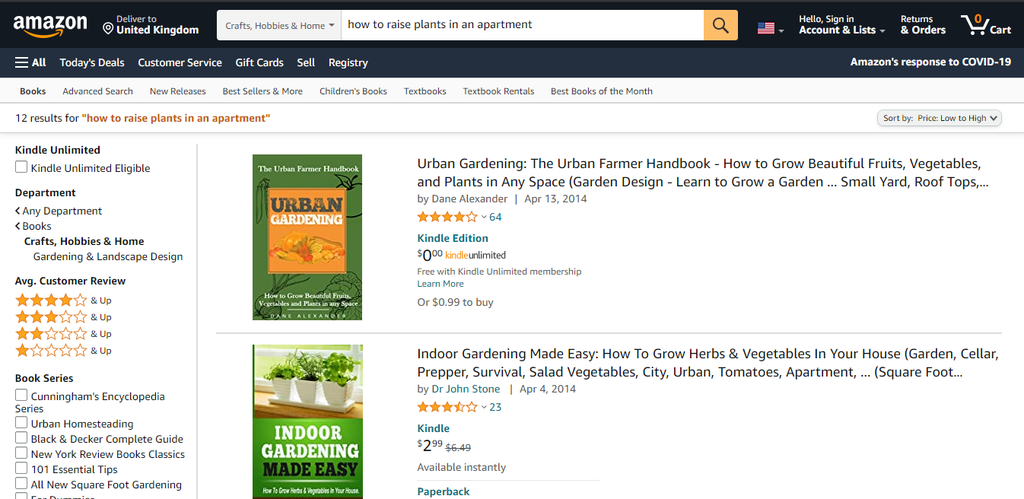
What makes your ebook unique?
Identify a gap in the market — something that doesn’t already exist. While the temptation is usually to cover big, popular topics, you will find many other people have the same idea. The more well-covered a topic is, the more competition your ebook will face, no matter how great it is.
But if your topic of choice has been covered before, don’t despair! It’s still possible to draw readers in with a unique angle, especially if what has already been published is written by an obscure author who hasn’t made the most of promoting their writing. The most important thing is to check out what has already been written and think carefully about your prospects of beating out that competition.
Let’s check in with our friend Jim to see how he’s getting on.
While researching his chosen topic, Jim can see a lot has been written about urban gardening before. There are already several ebooks available on Amazon for free discussing the topic. With stiff competition in mind, he decides to go back to the drawing board, to see how he can make his book stand out.
Knowing that most of his target audience spend time out of the apartment, Jim decides to write THE INVINCIBLE INDOOR GARDEN, all about how to create an indoor garden that’ll take the least amount of care and attention. He’ll emphasize the “busy young professional on the go” angle, knowing most of his readers are under 35 with disposable income.
4. Plan your structure with your solution in mind
A chapter-by-chapter outline will ensure you hit all the relevant points as you write your first draft. It will also save time in the editing process by keeping your writing tight and to the point.
So before you set pen to paper (or finger to keyboard), break down your overall aim in writing the book, your chapter headings, and the key points you want to make within each section. To give you a jumping-off point, here are a few structures to consider, depending on what fits your content best:
The “how-to” structure
If you’re writing a straightforward how-to guide, you’ll want to keep your structure linear. Dedicating a chapter to each step, and breaking those down into subsections if necessary, will make it easy to navigate and help your reader follow the sequence.
The “leveling up” structure
If you’re not providing an exhaustive how-to but are instead providing additional tips to help people level up their skills, you’ve got a lot of flexibility in terms of structure. You can dedicate a chapter to each tip, starting with the most basic tips to the most complex or you can order it based on the benefits each improvement will bring to your reader — the sky's the limit!
The “wait, but why?” structure
If you’re providing a unique solution to a problem, your readers may not understand why a new approach is necessary. Take some time at the beginning of the book to explain the problem with the status quo and what your proposed solution does better. You’ll want to relate back to this now and again during the following chapters, even if they follow a straightforward “how-to” structure from then on.
And what about our friend Jim?
Jim’s going to go with a hybrid ‘how to’ and ‘leveling up’ structure, because he’s dealing with people who need an outline of the very basics of plant care, but also want to improve their skills over time.
He also decides to split the book into three sections: a ‘how to’ beginning with the very basics, a section with tips dealing with issues that come up caring for plants in small spaces, and a section of tips specifically for people who are away from home a lot. This will mean readers can easily navigate the book using the table of contents if only one or two of the sections are of interest to them.
He’s going to divide his ‘hacks’ into a logical order from the most basic (choosing the right spot for your plant in the apartment) to the most complex (jury rigging a timed watering system that you only need to refill every few months, all for under $50).
5. Choose your writing platform
You can definitely draft your ebook text with a normal word processor, such as Microsoft Word. However, it’s worth considering using specialized book formatting software for your writing. This will save you time in the long run by ensuring that your text is already arranged optimally for an ebook before you even finish writing.
Having limited experience with ebook formatting, Jim might opt to write directly into a program that’ll do the heavy lifting for him, leaving him more time for literal heavy lifting in the plant store — after all, planters can weigh a ton.
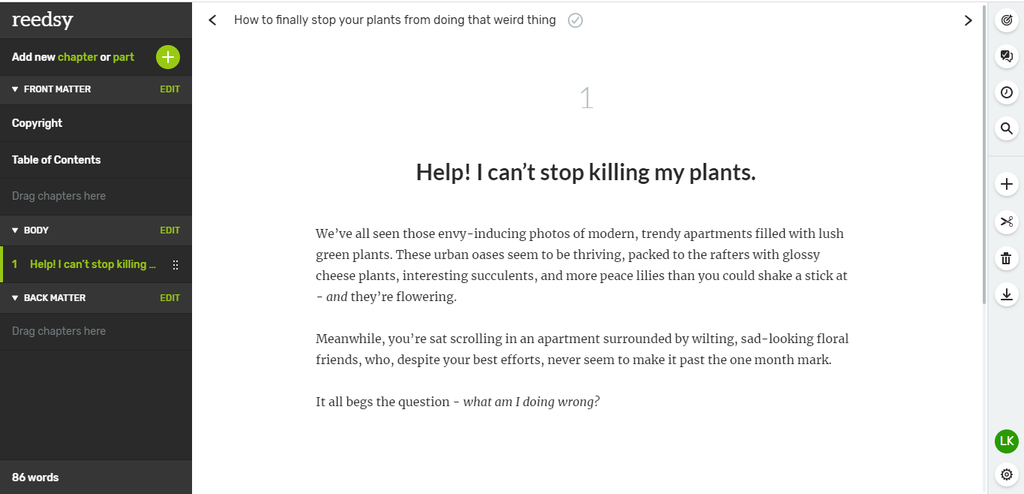
If you choose to write in a general use word processor, just know that you will have to go back and format your content into a proper book layout later. Customers will be reluctant to pay for or read a book that doesn’t look like the real deal. To convert your writing into a professional-looking ebook, you’ll want to consider chapter headings, line spacing, fonts, and other aspects of how the text looks on the page. Sounds complicated, but luckily we have our extensive guide to formatting a book to help you out!
6. Flesh out your plan with effective content
Now’s the time to do the actual writing part. If you’ve got a solid outline, this process shouldn’t be too rough. Just take it section by section, and remember that you can always come back and polish things up in the edit.
But those are general tips that apply to any type of writing. When writing an ebook for business, here are a few things you should bear in mind as you write.
Include the “why”
Within the introduction of your ebook, it’s a good idea not only to address what topics you’ll be covering but also to address why you’re writing this ebook in the first place. Underline the key need that you identified in your target research. Make sure people understand what the problem is and that you’re going to be the one to solve it. For example, Jim might say something like:
“Most plant care resources fail to address people whose lifestyles keep them out of the home. They’re unrealistic in their expectations for the amount of time people want to take on caring for their plants. This guide is for the person who loves plants, but can’t make plant-care their primary focus.”
Think about that target market again
You’d speak to a room full of experts differently than you would speak to complete novices in your field, and the same should go for your writing. Think back to your proto-persona and match your writing's tone to what they’ll want (and expect). If you’re providing solutions for industry professionals, you can pitch your writing's difficulty and complexity a little higher. If you’re writing an introductory guide, be sure to cut through any jargon, and take time to answer questions a complete newbie might have as you go.
Jim keeps his lingo pretty simple. Bearing in mind his millennial audience, he adopts a conversational tone. He doesn’t go too far with this, though, to avoid alienating other readers, or patronising those good ol’ millennials.
Data is key...
An ebook as a marketing tool shouldn’t just be pages of fluff. Pack in genuinely useful information or readers are unlikely to stick it out to the end (or believe what you’re saying). Data, statistics, and referenced facts will all help to bolster your credibility while adding educational value.
… But so is a good story
While facts and figures will bolster your writing's credibility, you don’t want to just present your readers with a dry list of facts. Incorporate storytelling into your writing by presenting examples and real-life stories wherever possible — leveraging social proof in this way is always compelling.
Jim will balance these two concerns by including plenty of the science behind why certain tips work (and other methods don’t), while also including anecdotes about his customers’ experiences and recurring problems, and how Jim helped them.
Add images and graphics
As we mentioned, not printing physical copies has the benefit of allowing you to pack your book full of images. Break up any text walls with illustrative pictures that help your reader understand what you’re talking about. Just don’t go too far with this — you don’t want your readers to feel shortchanged by a book that’s more images than text!
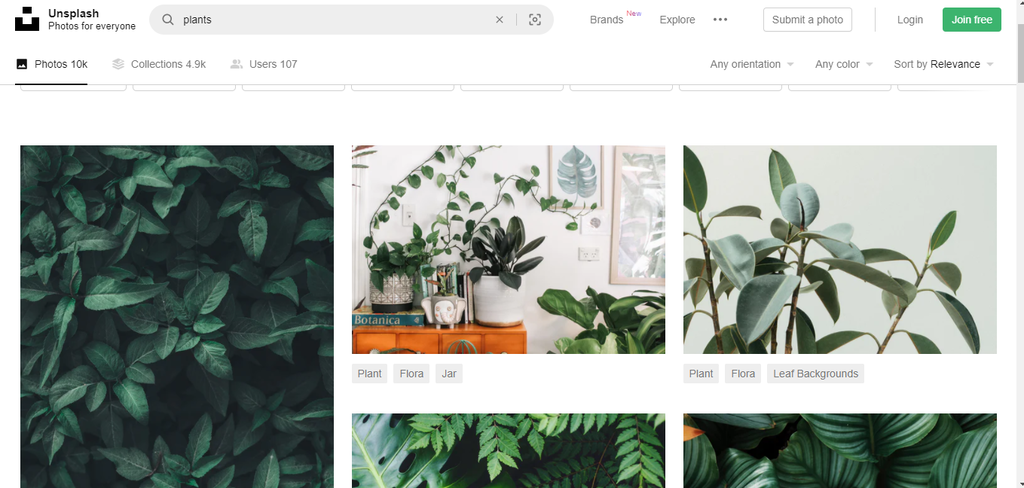
You might want to consider hiring a professional, like Jim, who will get custom images from a photographer to fill his ebook pages. These images can act as a sneaky advertisement for his stock and showroom, as he gets to show those off to potential customers. To keep costs low, he’ll also supplement with royalty free stock photos like the ones mentioned in our post about book cover pictures for a budget-friendly pictorial fix.
Make it personal
Obviously, you want to keep your ebook professional, but don’t be afraid to relate the content back to yourself and your business once in a while. It’s a fine balance to strike, but you should remind the reader who is writing. They’re far more likely to return to your business if they have gained a sense of who you are and what you do than if you present your ebook as an anonymous compilation of information.
Jim references his own plant care journey through the course of the book. He didn’t always have a green thumb, and pointing that out provides a compelling and reassuring ‘story’, even for a book that’s (on the surface) purely informational. It’ll also help build a relationship between Jim and his readers, as he understands their problems first hand and is therefore the man to come to for solutions.
Solve the problem you set out for yourself
By the end of the ebook, you should have answered the central question or provided a solution to the central problem you identified when picking your topic, and which you laid out in your introduction. Whether it’s showing them how to complete a task or explaining a complex concept, your ebook should provide something constructive to your reader. Highlight this in your conclusion so that your reader’s final impression is that your ebook has provided value to them.
Don’t give your readers the hard sell
As tempting as it is, the solution you offer your readers shouldn’t be buying your product. Ebooks are a marketing tool but not an opportunity for direct sales. Instead, your aim is to bring your audience onboard, engage with them, demonstrate your expertise and trustworthiness, and bring them onto your list of contacts. Direct sales can come later. If your ebook reads like an extended brochure for your product or service, it will be an instant turnoff to readers.
While Jim will naturally reference products he sells, the ebook shouldn’t be an extended sales pitch. Instead, he’s simply getting across that he’s a safe pair of (garden-gloved) hands in the world of plants, whose advice they can trust.
Include calls to action
Make the most of an ebook format by including calls to action within your writing. Linking to other helpful resources will not only make your ebook more useful but can also keep your reader within the ecosystem of your business for longer, provided you include links to your own content.
Jim will link out to blog posts he’s written on the hardiest types of plants, on the best type of plants to give as a gift to apartment-dwellers, and on videos he’s posted on YouTube showing his viewers how to repot and prune plants step by step.
Pro tip alert! 📣 Put any additional resources you link out to behind a subscription wall. This will mean that anyone who gets hold of your ebook through unofficial avenues (say, getting forwarded it by a friend or finding a reupload online) will also have to sign up to your mailing list to see that content. That way, you can ensure nobody slips through your lead capture net.
If you’re finding writing to be a chore, don’t forget that you can hire a ghostwriting collaborator to help you out! Whether you’re writing yourself, or bring in a little extra help along the way, bear in mind that there is still work to be done: the dreaded edit.
7. Edit to a professional level
Editing can be a drag, but it is absolutely essential to turn out a polished and professional manuscript. An overly-long and bloated first draft isn’t going to hold your reader’s attention. Equally, sloppy writing is going to be a major red flag for your reader. Your ebook is a reflection of you, and by extension, your product or service — so don’t let silly mistakes ruin your credibility!
After writing, it’s usually best to wait a few days before looking back over your work. Then read through it start to finish, and ask yourself:
- Have you addressed the question or problem you set out for yourself?
- Have you hit all the points you wanted to?
- Does your writing sound convincing and professional?
If the answer to any of these questions is “no,” you’ll need to make revisions.
It’s definitely worth doing an initial editing pass yourself to address these problems (self-editing is one of the key steps in any writing process). Still, if you want to turn out a truly professional piece of work, you’ll want to consider hiring a professional editor. Luckily, various editors can help you out, from developmental editing (the big picture stuff) to proofreading (the granular stuff, like spelling and grammar).
8. Get it out into the world!
Okay, that oversimplifies it a little. But once you’ve come up with your concept, written, and edited your ebook, you really are on the home stretch!
Your next big task is probably going to be putting together a professional-looking cover. Again, your ebook is a reflection of you, so it’s important to make sure this cover is something you’re proud of. The temptation to cobble together your own cover is understandable, but it can be worth investing in a professional's services. It’s the first thing your readers will see, and a bad cover will make your book look amateurish and undermine the hard work you put into writing.
Once you’ve perfected your writing and found your killer cover, you're ready for the next step: making the perfect ebook.


